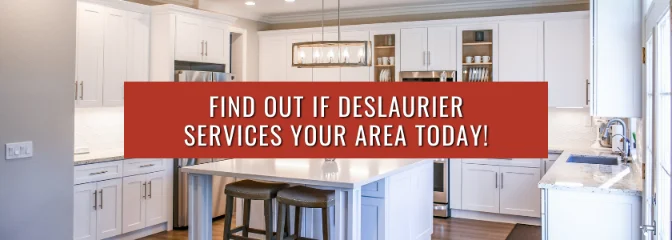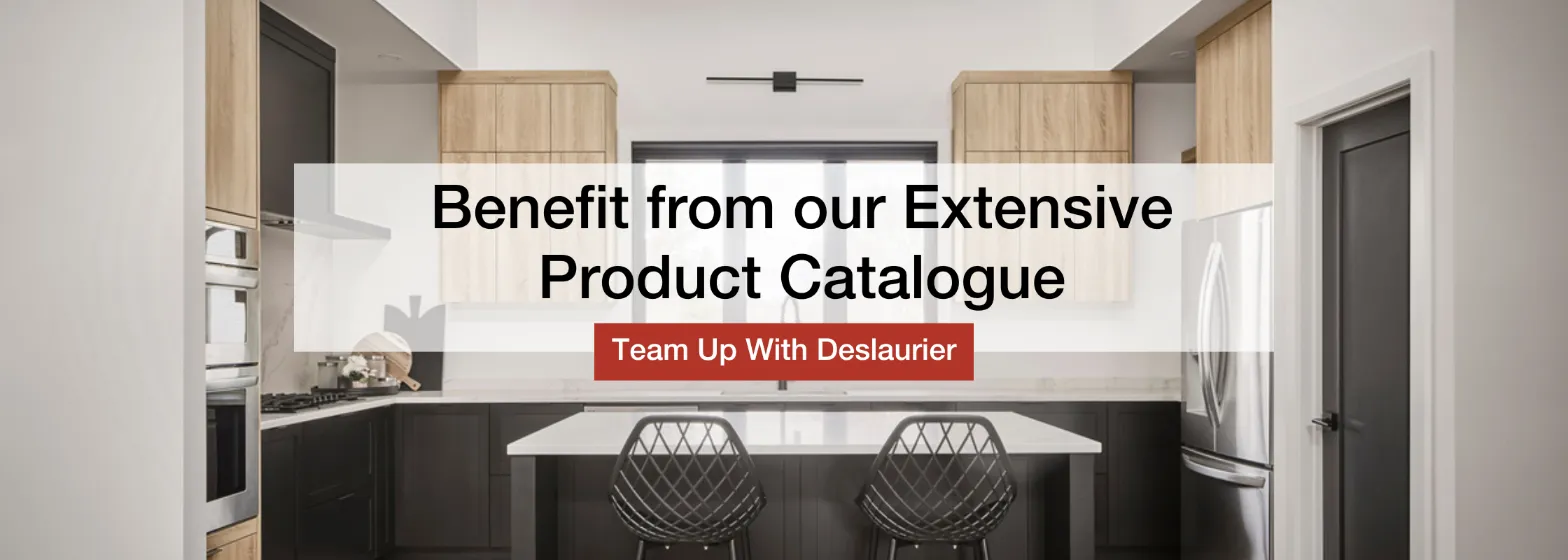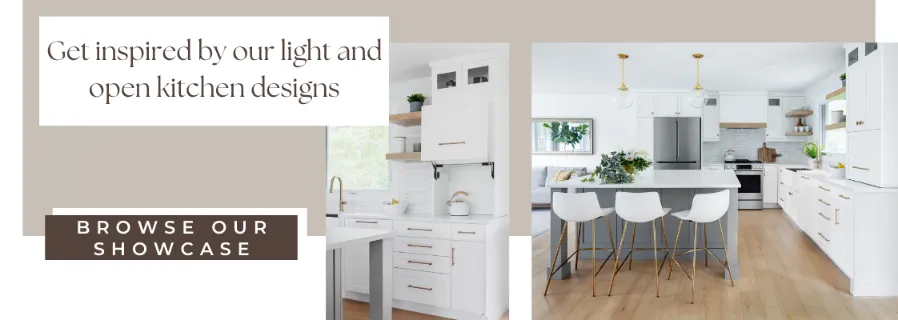26/04/2023 • Blog
Common Problems with Kitchen Retrofitting
Estimated Read Time: 9 Minutes
When it comes to home improvement projects, there’s no more exciting endeavour than updating your kitchen.
Whether you want to update its dated appearance, create a more functional layout, or increase the resale value of your home, there’s no shortage of possibilities.
But not all kitchen projects are the same. One important decision you'll need to make is the depth of your alterations. Are you planning on modifying or replacing a specific area (retrofitting) or undergoing a more thorough renovation?
At Deslaurier, we have over 40 years of experience manufacturing custom cabinets and providing kitchen design expertise. While we do not offer renovation services, we have spent decades partnering with contractors and renovators to give our clients the custom kitchen of their dreams.
In that time, we’ve seen the good (and the bad) that comes with trying to retrofit features in an existing kitchen.
In this article, we'll explore the concept of kitchen retrofitting, identify five common problems that can arise, and explain why Deslaurier doesn't typically undertake retrofitting projects. To shed light on these topics, we'll also hear from Design Consultant Adele Jacobs.
Let’s get started!
|
Table of Contents |
|
Retrofit Compared to a Renovation
Why Deslaurier Doesn’t Retrofit |
What is a Kitchen Retrofit?
Retrofitting your kitchen involves upgrading or modifying your existing structure, system, or equipment to fit new or updated features into your current layout. It can also include making modifications without altering the kitchen's layout or design.
Think about creating a bit of extra space for a new refrigerator.
“If the floorplan’s not changing at all and you’re just replacing cabinets and countertops, that, to me, is a complete retrofit” - Adele Jacobs
Retrofitting your kitchen doesn't always require a major overhaul.
Instead, you can make smaller modifications like upgrading your existing cabinets with new interior hardware and accessories.
By adding features such as replacement drawers, pull-outs, lazy susans, or appliance lifts, you can improve your kitchen's functionality and storage capacity while keeping your existing layout intact.
Retrofit vs. Renovation
Retrofitting your kitchen is a more modest undertaking compared to a complete renovation. Typically, it involves making targeted upgrades or replacements to a particular area or feature of your kitchen and making smaller modifications around that space.
A renovation is a large-scope project that could involve altering the kitchen layout, removing walls, and replacing flooring, cabinets, and countertops.
“It is very different from a complete remodel. There will be sacrifices you’ll probably have to make if you’re doing it that way.” – Jacobs
If your initial plan involves needing to remove cabinets and create more space, it’s probably better for a renovation. You’ll most likely need to replace cabinets and countertops, which requires a much more extensive change than just some slight modifications.
Reasons to Retrofit Your Kitchen
So, why retrofit instead of renovating?
Maybe there’s some localized damage in one specific area of your kitchen that you’d like to address and replace. Or generally bringing the kitchen up to a more current standard with new features to provide increased functionality.
A common feature that might need retrofitting is after purchasing new appliances.
New appliance models are often larger and different sizes than older models, especially refrigerators. Because of that, they most likely won’t fit into the existing space of your current appliances.
Particularly if they’re built into your cabinetry design, trying to get your new appliances into these spaces will call for a retrofit to alter surrounding cabinetry and millwork.
It can become more of an extension of your current design. It also alleviates some challenges (like trying to match the door style and finish) that we will detail below.
“When it's being done as a complement to the kitchen as opposed to a complete replacement, that’s when I think a retrofit is a fine idea.” – Jacobs
You would want to retrofit if you’re able to work a different style or colour of cabinet into your kitchen. That’s a great way to create a two-tone cabinet design.
To make this work, it's important to ensure a smooth transition between the old and new cabinets.
You can add a pantry wall unit or use an appliance as a buffer, with the new set of different colour cabinets beginning on the opposite side. This approach allows you to incorporate the new features and functionality you want without trying to match or change your existing cabinets.
Problems with Retrofitting
With that being said, let’s look at some common problems you might encounter when trying to retrofit your kitchen with matching cabinetry.
1. You Can’t Always Get The Same Products
The primary concern is being able to match “perfectly” with your existing cabinets. Naturally, homeowners will often re-enlist the services of their initial cabinet supplier for new replacements to match their existing cabinet design.
While that’s likely the best course of action than going with a new supplier with a totally different product catalogue, two main issues can arise:
- Does the door style still exist?
- Is the material still available?
Most likely, it’s been years (if not over a decade) since your kitchen cabinets were installed. In that time, the cabinet manufacturer may have slightly changed their products or removed them entirely.
“It’s not that we can’t get the cabinets – it’s having them match your existing cabinets.” - Jacobs
At Deslaurier, our product styles are constantly evolving. What was popular 10 or 15 years ago, may not be popular anymore. Our catalogue reflects that.
Even timeless selections like shaker doors could be slightly different. A manufacturer could reduce or increase the width of their stiles and rails, as an example. The door style would then have the same “shaker” design but would have slightly different dimensions that won’t perfectly match.
Secondly, the material itself won’t always be the same or available at all.
For example, the Deslaurier cabinet materials available 10 years ago would look a bit different than it does now.
Two cabinet wood species that we no longer provide are knotty pine and hickory. If a former client were to approach us for new kitchen cabinets, they would not be able to match their existing cabinetry with those woods.
Even smaller differences like changing the lumber supplier or location where the wood was sourced can be enough of a change that it’s visibly noticeable.
2. Natural Changes in Wood Cabinets
Speaking of natural wood cabinets, there are several organic changes that happen to them over time.
Wood cabinets undergo a natural occurrence known as “breathing”— they expand and contract due to changes in temperature and humidity. This movement can cause visible joint cracking in 5-piece painted doors or styles with applied mouldings.
If you have years-old wood cabinets, you may have already noticed this phenomenon to some extent.
These issues are largely why MDF has become the go-to material for painted cabinetry!
Hardwood also changes over time from age and exposure to lighting. While this happens to every material, two wood species, in particular, have natural aging processes that make them incredibly difficult to match with new cabinets: cherry and walnut.
Starting almost as light or golden pink, cherry gradually gains deep, alluring reddish-brown hues as it is exposed to oxidation and natural lighting over time.
The opposite aging process is true for walnut cabinets. With time, the dark brown colour of walnut naturally begins to lighten.
These unique aging processes are part of the distinct beauty associated with purchasing natural wood kitchen cabinetry. They also make it virtually impossible to replicate a convincing aging process on new cabinets.
3. Paints and Stains
Wood isn’t the only thing vulnerable to aging. Cabinet finishes themselves can fade with time or change their appearance from consistent exposure to lighting.
“The issue is if that finish has been exposed to light, it’s going to change slightly. To deal with that particular issue we do a custom colour match.” - Jacobs
A custom colour match is a labour-intensive process that involves extra time and expenses.
To put it simply, concocting a custom colour means hands-on experimentation with a base colour (usually grey or white) and 5-11 unique tints (other colours like yellows, blacks, greens and blues).
Once a formula is created, the colour gets tested in a lightbox to see how it would look in a real kitchen. And even after all that, it’s unlikely to match the natural, inconsistent aging of your current cabinets.
These new cabinets will look somewhat visibly “fresher” than your existing ones. You might not realize just how faded your cabinets are until the new ones are installed next to them. Any finish will change over time, and a fresh cabinet will be noticeable compared to what you are used to.
Further, the actual stain or paint itself might have been altered. The chemistry of the finish could be different from the original formula used on your older cabinets.
“Companies change their formulas to be greener, or because manufacturers have discontinued certain items.” - Jacobs
They could have also moved from a solvent to a water-based paint. There are a number of different variables that could result in a noticeably different finish.
4. Countertop Damage
Of course, it’s not just the cabinets that will be disrupted during this process. Your countertops might also need to be altered.
Simply put, if you plan on retrofitting a kitchen that has stone countertops—you can forget it.
Very few countertop fabricators, if any, will come and cut or modify your existing stone countertops on-site.
And if you try to remove your countertops to customize them and put them back on after, those surfaces can break. It’s a very tricky process, not just removing the surfaces but re-installing them as well.
Not to mention, backsplash tiles or wall paint will almost certainly be damaged during this process. Once you get into those ancillary issues, you may as well go with a full-blown renovation. Or at least be prepared to replace them.
The one exception to this is laminate. Laminate countertops are much easier to remove and if they do become damaged, they are far more affordable to replace than stone surfaces.
5. One Thing Leads to Another (The Ripple Effect)
As we’ve mentioned, retrofitting is a much more limited project than a renovation. You won’t get the in-depth changes of a renovation—before it slowly becomes one.
If you have the luxury of just doing one portion of your kitchen that won’t affect any other section, then that is fantastic.
Most features in your kitchen are attached to something else.
Look at that designated area you’d have to alter and ask yourself, “If I change this, what does it mean for everything around it?”
Otherwise, there will most likely be spillover or a “domino effect” that will impact places next to that original area, drastically increasing the scope of your project.
Why Deslaurier Doesn’t Retrofit
We get plenty of requests to retrofit, from previous clients and inquiring homeowners alike. By far, the most common request comes from homeowners that just bought new appliances (typically a refrigerator) and need to alter the surrounding cabinets or millwork panelling.
There are several reasons why Deslaurier does not offer retrofit services, including many of the problems listed above.
Firstly, is project size.
For us, most retrofitting projects are too small and not economically feasible. Such projects may only involve a couple of cabinets and an additional side panel, and when you factor in the labour-intensive process of custom colour-matching the existing cabinets, it may not be worthwhile for our manufacturing and production efficiency.
The second, and primary reason, we do not retrofit is installation. Our team of professional cabinet installers are just that: installers.
Our installers strictly install new cabinets, they don’t cut down cabinets or alter existing kitchen elements like millwork or toe-kick. If the retrofitted area isn’t perfect for cabinet installation, there’s nothing more we can do.
These are things best suited for carpenters and renovators.
Should You Retrofit or Renovate?
With any home improvement project, it’s important to remember that unforeseen issues could arise along the way.
You’re going to get a far more finished and clean outcome if you’re able to start from scratch and plan a proper renovation rather than a retrofit. The final product is simply much better.
“If you have an older kitchen that’s probably due for an upgrade anyway, you will save time and money in the long run by doing a complete cabinet replacement (renovation)” - Jacobs
Of course, it is much more expensive to perform a complete renovation and isn’t feasible for every homeowner’s budget. But it gives you the chance to address any issues in your kitchen as well.
Of course, every project is unique. That’s why it’s important to always consider your budget, lifestyle, and long-term plans before determining the scope of your project!
Design with Deslaurier Custom Cabinets
As you can see, not every home improvement project is the same. The intent of this article was to let you know that kitchen retrofitting is not an easy thing to do. A small portion of kitchens could benefit from a retrofit, but for the most part, performing a remodel is the better option.
If you have your eye on custom cabinetry for your upcoming kitchen project, Deslaurier Custom Cabinets has everything you need. With over 40 years of experience in our name, we provide our clients with a fully customized design process with our talented team of designers.
Book a free consultation today with a Deslaurier kitchen expert at our Jupiter, Florida showroom!
Live outside the area? Find a Dealer to connect with near you! Interested in becoming an authorized Deslaurier dealer? Visit our Become a Dealer page to learn more!


